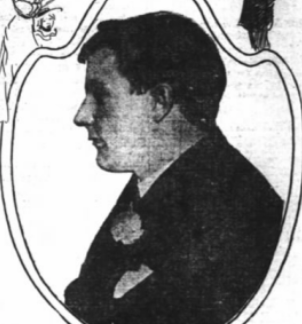 The Inter Ocean, March 27, 1906.
On the evening of September 12, 1904, three armed robbers entered Hans Peterson’s cigar store in Chicago, Illinois. When the robbers ordered Peterson to put his hands up, he refused. One of the robbers then shot and killed him. Several employees and shoppers, as well as Peterson’s son, witnessed the shooting. Peterson’s wife was in the next room and heard the shots but did not see the shooter. William Portee, an employee, was shot in the chest but survived.
Portee spoke with police at the hospital shortly after the shooting.
Within hours of the crime, police arrested Joseph “Jocko” Briggs. Briggs worked for the Chicago, Milwaukee, and St. Paul Railway Company and lived with his wife and two children about a half-mile from Peterson’s store. Briggs had a previous burglary conviction. He was seen at a bar in the vicinity of the robbery, and a streetcar conductor named James Cullen identified Briggs as having boarded his streetcar near the time and place of the crime.
Officers brought Briggs to Portee’s hospital room on September 13, 1904. According to later testimony from police and Portee, Portee positively identified Briggs at that time. Briggs, however, later said he overheard Portee expressing uncertainty about whether Briggs was actually the shooter or just looked similar.
A second witness, 12-year-old Albert Piemental, viewed Briggs at the police station that day and, according to police and Piemental, identified Briggs as the shooter.
On September 22, 1904, 17-year-old John Smith confessed to his involvement in the crime while being questioned by police, and he implicated John “Lefty” Leonard, Harry Brown (also known as Harry Shelton), and Briggs as accomplices.
On September 29, 1904, a Cook County grand jury indicted Briggs, Leonard, and Smith, for the murder of Peterson. Available records do not indicate why Brown was not indicted.
In October 1904, newspapers reported that Smith had recanted his confession, saying he knew nothing about the crime and that the confession had been the result of physical brutality by Lieutenant John O’Hara and his detectives. “Everything I said to Lieutenant O’Hara was a lie,” Smith said. He said O’Hara had beaten him in the presence of two detectives until he confessed.
Briggs was tried for Peterson’s murder in late February 1905 in the Criminal Court of Cook County. Judge Joseph Gary presided, and Assistant State’s Attorney Robert Holt prosecuted the case. Robert E. Cantwell represented Briggs. Portee and Piemental each testified and identified Briggs.
Matilda Peterson (no relation to the victim), a regular customer at the cigar store, identified Briggs as the man she had seen in Peterson’s store the day before the crime, requesting change for a $10 bill. Several witnesses testified that Briggs had been at home sick the day before the murder, contrary to Matilda Peterson’s testimony.
Briggs testified, and he was asked about Portee’s initial uncertainty about his identification in the hospital room. However, the prosecution objected to this line of questioning and Judge Gary sustained the objection.
Several witnesses testified that Briggs was in one of several saloons a few blocks from the store at the time of the crime. Briggs and others testified that he had received his paycheck that morning and spent the day paying off his tabs with saloon keepers.
Newspaper articles noted that Briggs said that he was a victim of mistaken identity.
The jury found Briggs guilty of murder on March 4, 1905, and he was sentenced to death.
After coming within a day of his scheduled execution, Briggs filed a motion for a new trial based on newly discovered evidence, improper jury instruction and improper questioning of a witness. On December 20, 1905, the Illinois Supreme Court reversed Briggs’s conviction and remanded the case. The Court said that Judge Gary had erred in not admitting evidence regarding prior inconsistent statements by Portee, where he expressed uncertainty about his identification of Briggs.
Available records do not indicate whether Smith’s and Leonard’s cases ever went to trial.
Beginning March 29, 1906, Briggs’s second trial for Peterson’s murder began, now with Judge Axel Chytraus presiding. Holt again prosecuted the case, and Cantwell continued to represent Briggs.
Prior to the trial, a woman named Minnie Wagner-Feinberg told police that her deceased husband had told her he had killed Hans Peterson. Wagner-Feinberg’s husband told her that a man named “Edwards” had assisted him. Although Wagner-Feinberg said in an affidavit that Edwards looked like Briggs, she said that after viewing Briggs, she could tell he was not the same person. Cantwell attempted to have this affidavit admitted as evidence, but the prosecution objected on the grounds that a wife could not testify against her husband. Available records do not include information on whether this testimony was admitted into evidence.
Peterson’s wife and son testified for the prosecution, though neither could identify the shooter. Portee testified and again identified Briggs as the shooter. Available records do not address whether Portee was questioned about his initial uncertainty. An alibi witness named Mrs. Lally was on the stand when she pointed out Sergeant Edward McNally and said that McNally had tried to intimidate her to keep her from testifying for the defense. Several other witnesses also testified to Briggs’s presence in a particular saloon at the time of the crime.
On April 7, 1906, the jury acquitted Briggs after an hour of deliberation. - Meghan Barrett Cousino
|